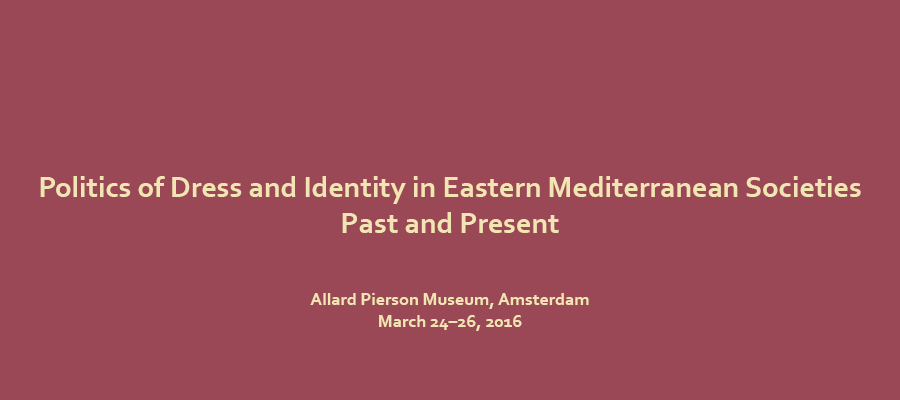Politics of Dress and Identity in Eastern Mediterranean Societies, Past and Present, Allard Pierson Museum, Amsterdam, March 24–26, 2016
An international symposium organized by the Fitting in/Standing Out project (NWO), Vrije Universiteit Amsterdam, the University of Salento (Lecce), and the Allard Pierson Museum (Amsterdam)
Dress plays an essential role in the presentation of the self and in the perception of the other. Clothing and headgear, as well as accessories, tattoos, and hair styles, overtly state and sometimes more subtly convey information about a person’s social standing, gender, ethnicity, regional background, affiliations, profession, or religious beliefs – in other words, about the particular position (s)he holds, or would like to show as having, at a certain moment in time within a certain group or society. Dress is also part of the negotiation of identity and status; it allows individuals to articulate, or conceal, different identities, whether these are individual or collective, imposed or chosen. Identificational changes – when entering a new phase of life or assuming a new status or role – are often marked by the rejection of certain dress codes and/or the acquisition of new ones. Similarly, transient identities can be expressed through a new or composite dress vocabulary. Although dress is usually perceived, understood, and represented as an unambiguous statement about one’s identity, it is in fact a source of many potential ambiguities. The meanings and symbolic values associated with dress are not only culturally situated; they are also dependent on the time and place, the wearer, and the audience. Moreover, they constantly change over time.
This international symposium takes an interdisciplinary, diachronic, and comparative approach to explore the interplay between dress and identity in the broader Mediterranean basin, with a special focus on Muslim societies and interconnected cultures, in both the past and present. It aims to bring together anthropologists, sociologists, historians, art historians, archaeologists, and scholars of other disciplines working on this subject, using a wide spectrum of methods – from textual to textile analysis. The study of dress and, in particular, of attempts to control the meanings of dress – whether in practice, depictions, or texts – not only has great potential for social and cultural history, but is also crucial to understand sartorial dynamics within contemporary societies. From the sumptuary laws issued in many ancient societies to the contemporary debate on veiling practices among Muslim women, dress is, and has always been, the site of competing discourses, where authority and resistance, and the interests of the community and those of the individual meet. By bridging the gap between different academic fields, this symposium aims to put perceptions of dress in the past and the present into a broader perspective.
The main themes we aim to discuss are:
- How is dress used to reify or challenge community boundaries? How do intersecting identities influence choices in dress?
- How is dress represented in visual and written sources? What is the relation between these and actual dress practices? How do these images and texts contribute to construct, reinforce, or subvert identity categories?
- How do actual garments, depictions of dress, or discourses on dress refer to the past (i.e. religious or cultural traditions) to legitimize the present?
- What role does dress play in the articulation of transient or multiple identities, for example in cases of conversion, migration, or the assumption of a new social status?
- How do political, economic, and cultural connections between the East and the West influence dress? How is exotic dress appropriated locally to negotiate status and identity?
Scholars, PhD candidates, and advanced MA students doing research related to the subject of dress and identity are invited to submit a proposal for the symposium.
